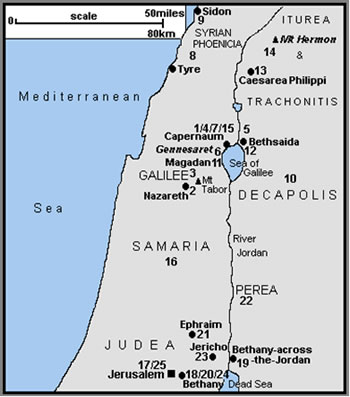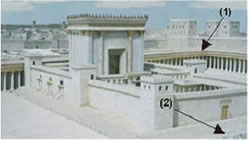The Travels and Acts
of Jesus in Year Three of His Ministry c
AD29-30

THIRD
PREACHING TOUR OF
[1] Jesus
travels from
[2] In
[3] He continues through
the Gospel (Mt 10:5; Mk 6:7; Lk 9:1)
[4] The
Twelve return to
[5] From
(Lk 9:10). Here he feeds the 5,000 (Mt
14:14; Mk 6:33; Lk 9:11; Jn 6:5)
[6] The disciples return across the
water to join them (Mt 14:25; Mk 6:48;
Jn 6:19). They land near the Plain of
Gennesaret
and Jesus heals many people there (Mt 14:34; Mk 6:53)
[7] From Gennesaret they make their way back
to
the Bread of Life (Jn 6:26)
JESUS PREACHES AND HEALS IN SYRIAN-PHOENICIA, ITUREA and TRACHONITIS, THE DECAPOLIS
[8] Jesus
retires from Galilee to the region of
Mk 7:24) where he heals the daughter of
the Gentile Syrophoenician woman (Mt
15:22; Mk 7:25).
[9] He
leaves Syrian-Phoenicia via
[10] In the
[11] Reaching the
(Mt 15:39; Mk 8:10). There the
Pharisees and Sadducees ask for a sign
from heaven (Mt 16:1; Mk 8:11)
[12]
Continuing on to
[13]
Jesus now travels from
Peter confesses that Jesus is the Christ (Mt 16:13; Mk 8:27)
[14] Continuing on from Caesarea Philippi
possibly further north towards
of the
disciples see Jesus Transfigured in the presence of Elijah and Moses (Mt
17:1; Mk
9:2; Lk 9:28). On his return, Jesus heals the
boy with epilepsy (Mt 17:14; Mk 9:14; Lk
9:37). Other traditions place the
Transfiguration to the south, on
The epileptic boy would then have been
healed in the
[15] In
Galilee (Mt 17:22; Mk 9:30) in
a fish! (Mt 17:24). Then to avoid the
dangers in Judea, he remains in
LATER MINISTRY IN JUDEA
[16]
Jesus leaves
for
(Lk 17:11) but is rejected in a Samaritan village (Lk 9:52)
[17] Arriving in
of c AD29 (Jn 7:10), Jesus forgives the woman caught in adultery
(Jn 8:2) and heals the blind man who is
taken before the Sanhedrin
(Jn 9:1)
[18] During his travels in Judea, Jesus visits
Martha and Mary in
(Lk
10:38), returning to
Dedication
in December c AD29 (Jn 10:22)
THE LAST FEW MONTHS - c AD30
[19] Jesus withdraws to Bethany-across-the-Jordan (or Bethabara "where
John had first baptised"), and into the province of Perea, and stays for a while (Jn 10:40)
[20] Following the death of Lazarus, Jesus
returns to
[21] Because of threats to his life, Jesus
withdraws to Ephraim to the north of
HIS MINISTRY IN PEREA (MODERN JORDAN)
[22] He
then crosses the River Jordan and works
in Perea (Mt 19:1; Mk 10:1). There he blesses the little
children (Mt 19:13, Mk 10:13; Lk 18:15) and speaks to the rich young
man (Mt 19:16; Mk 10:17; Lk 18:18)
THE FINAL JOURNEY TO JERUSALEM
[23]
Jesus now travels towards
Passing through
and converts
Zacchaeus the tax collector (Lk 19:1).
[24] Reaching Bethany (Jn 12:1) the home of Lazarus, Mary and Martha,
Jesus is anointed by
Mary either now (Jn 12:2), or later (Mt 26:6; Mk 14:3) after his
triumphal entry into
[25] During the
Easter week, Jesus returns to
John 10:19-42
This
section continues to focus on who Jesus is.
Theologically it is foundational for Christology.
Jesus
is the Messiah 10:22-30
Jesus
is the Son of God 10:31-39
From
this section we can conclude that Jesus is either the Son of God and the
Messiah or else he is either:
a)
very misrepresented by John
b)
is “demon-possessed or raving mad” (11:21
10:19
10:20
10:21
10:22
Feast
of Dedication was an eight day feast or Hanukkah (also called the Feast of
Llights). It was instituted in 165 by
Judas Maccabeus after cleaning the
10:23
Because it was winter Jesus
taught in the long hallway called Solomon’s colonnade on the east side of the
temple courtyard. The colonnade.

10:24
Jesus
had told people that he was the Messiah.
(the woman at the well, his disciples, etc.)
But
he had not made a public announcement because all kinds of people including the
patriots and the militias would have made a move. So in this sense Jesus had not reveal himself
to the public, but for those that had been listening he was very clear.
10:25
Jesus
had done the works that the Messiah would do.
Anyone
could come and make a public announcement, “I am the Messiah.”
Only
Jesus could do the works of the Messiah.
His works spoke for him.
10:26
10:27
10:28
“never
perish” does not mean they will never have earthly trouble but that they will
be delivered inspite of earthly trouble.
“My
Hand” vs. 29 “My Father’s Hand”
10:29
“My
Father’s Hand”
10:30
“One”
is neuter and not femine or masculine.
In the Greek this means “One Thing”.
To mean “One Person” it would have to be masculine (or, feminine).
POINT: Jesus and the Father are the same “thing”,
they both have the character of God.
They
are not the same person so Jesus is not the Father and the Father is not
Jesus. The Greek does not say that.
10:31
The
Jews asked for a statement of his Messiahship and he told them that He and the
Father were the same thing or of the same divine essence. It was more than they wanted to hear. In their theology the Messiah may have been a
great man that God anointed but for a man to claim to be God is more than they
can handle.
10:32
Jesus
stops the stones by asking a question
Jesus
brings them back to the miracles since that was his proof of his claim.
10:33
Jesus
does not try to correct the Jews accusation, “You. . . claim to be God.”
10:34
“It
stands written” is John’s formula for citing scripture as proof.
In
Psalm 82:6 the term “gods” (eloim) is
used to refer to
Jesus’
point is if God’s own word calls men “gods” why should the Jews be upset with
Jesus applying something that could be very similar.
The
judges (similar to authority and government) stood in the place of God before
the people.
Jesus may be trying to get them to argue about the proper use of the word
“eloim” and its reference to man before they consider if He is God.
Basically
Jesus stalled his execution for blaspheme by citing Jewish scripture that said
the same thing.